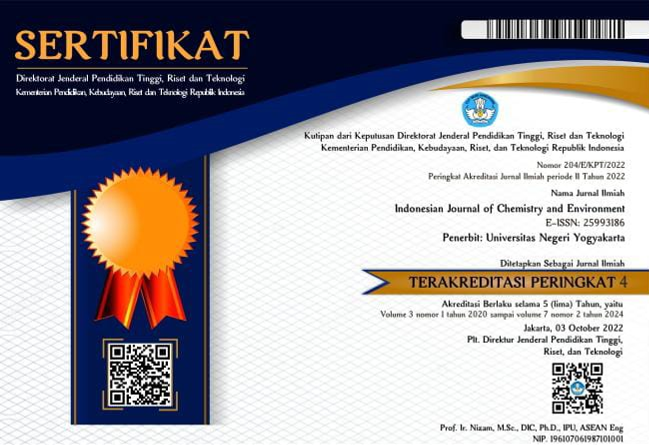Virtual Screening, Pharmacokinetic Prediction, Molecular Docking and Dynamics Approaches in the Search for Selective and Potent Natural Molecular Inhibitors of MAO-B for the Treatment of Neurodegenerative Diseases
DOI:
https://doi.org/10.21831/ijoce.v6i2.68338Abstract
This research aims to find natural product compounds that have the potential to act as MAO-B inhibitors that are useful in the treatment of neurodegenerative diseases, through the stages: a) Virtual Screening, b) Molecule Docking, c) Pharmacokinetic and toxicity prediction, and d) Simulation approach Molecular dynamics.
The research steps include the following steps: a) searching for molecules in the ZINC15 data base that are similar to the natural ligand molecule (safinamide) obtained from the protein data bank (PDB code: 2v5z) and the control ligand L-DOPA. A total of 481 molecules were downloaded from the data base and then molecular docking was carried out using the autodock program on the MAO-B target in the 2v5z receptor. After carrying out the docking analysis, 48 ligand molecules were selected which had a binding affinity (DG/kcal/mol) that was smaller than the DG of the natural ligand and the control ligand and nine (9) ligand molecules were taken to be tested: (i) ligand-ligand interactions MAO-B with discovery studio, (ii) Absorption, Distribution, Metabolism and Excretion properties with SwissADME and (iii) toxicity using PROTOX-II. Molecular dynamics simulations were carried out to determine the stability of ligands in proteins. Ligand complex [CC(C)c1ccc(NC(=O)Cn2cnc3c2c(=O)n(C)c(=O)n3C)cc1]-2v5z was chosen to simulate for 100 ps. The results of the molecular docking study showed that there were 9 molecules that had binding affinity values that were smaller than the binding affinity of the natural ligand and the control ligand. Ligand and residue interactions are dominated by hydrogen bonds, donor-donor and pi-pi stacked interactions. Based on SwissADME, the Blood Brain Barrier (BBB) permeant on ligand number 1, 2, 3, 5, 6, and 9 shows that it is orally active and cannot pass through the BBB and will not cause any side effects, whereas ligand number 4, 7, 8, 10, and 11 can cross the BBB and may cause side effects. Based on the results of toxicity prediction (PROTOX-II), it is known that there are four (4) ligands in class V, five (5) ligands in class IV and the rest in class II. Hepatotoxicity, carcinogenicity, and Phosphoprotein (Tumor Suppressor) p53 in eleven ligands are predicted to be inactive and have a small probability. The stimulated [CC(C)c1ccc(NC(=O)Cn2cnc3c2c(=O)n(C)c(=O)n3C)cc1]-2v5z complex apparently still shows ligand-protein fluctuations so that its conformation is still unstable.
Downloads
Published
How to Cite
Issue
Section
License
Authors who publish with this journal agree to the following terms:
- Authors retain copyright and grant the journal right of first publication with the work simultaneously licensed under a Creative Commons Attribution-NonCommercial-NoDerivatives 4.0 International License that allows others to share the work with an acknowledgement of the work's authorship and initial publication in this journal.
- Authors are able to enter into separate, additional contractual arrangements for the non-exclusive distribution of the journal's published version of the work (e.g., post it to an institutional repository or publish it in a book), with an acknowledgement of its initial publication in this journal.
- Authors are permitted and encouraged to post their work online (e.g., in institutional repositories or on their website) prior to and during the submission process, as it can lead to productive exchanges, as well as earlier and greater citation of published work.









